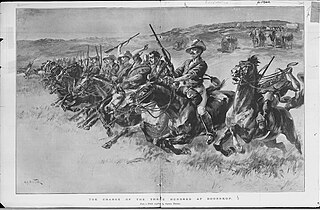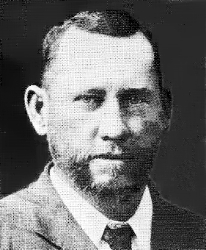
The Union of South Africa was the historical predecessor to the present-day Republic of South Africa. It came into existence on 31 May 1910 with the unification of the Cape, Natal, Transvaal, and Orange River colonies. It included the territories that were formerly part of the South African Republic and the Orange Free State.

The Transvaal Colony was the name used to refer to the Transvaal region during the period of direct British rule and military occupation between the end of the Second Boer War in 1902 when the South African Republic was dissolved, and the establishment of the Union of South Africa in 1910. The borders of the Transvaal Colony were larger than the defeated South African Republic. In 1910 the entire territory became the Transvaal Province of the Union of South Africa.

The Jameson Raid was a botched raid against the South African Republic carried out by British colonial administrator Leander Starr Jameson, under the employment of Cecil Rhodes. It involved 500 British South Africa Company police and was launched from Rhodesia over the New Year weekend of 1895–96. Paul Kruger, for whom Rhodes had great personal hatred, was president of the South African Republic at the time. The raid was intended to trigger an uprising by the primarily British expatriate workers in the Transvaal but it failed.

The Province of Transvaal, commonly referred to as the Transvaal, was a province of South Africa from 1910 until 1994, when a new constitution subdivided it following the end of apartheid. The name "Transvaal" refers to the province's geographical location to the north of the Vaal River. Its capital was Pretoria, which was also the country's executive capital.

Christiaan Frederick Beyers Naudé was a South African Afrikaner Calvinist Dominee, theologian and the leading Afrikaner anti-apartheid activist. He was known simply as Beyers Naudé, or more colloquially, Oom Bey.

Johannesburg is a large city in Gauteng Province of South Africa. It was established as a small village controlled by a Health Committee in 1886 with the discovery of an outcrop of a gold reef on the farm Langlaagte. The population of the city grew rapidly, becoming a municipality in 1898. In 1928 it became a city making Johannesburg the largest city in South Africa. In 2002 it joined ten other municipalities to form the City of Johannesburg Metropolitan Municipality. Today, it is a centre for learning and entertainment for all of South Africa. It is also the capital city of Gauteng.

The Witwatersrand Gold Rush was a gold rush that began in 1886 and led to the establishment of Johannesburg, South Africa. It was a part of the Mineral Revolution.

The Rand Afrikaans University (RAU) was a prominent South African institution of higher education and research that served the greater Johannesburg area and surroundings from 1967 to 2004. It has since merged with the Technikon Witwatersrand and two campuses of Vista University to form the University of Johannesburg.

During the Napoleonic Wars, the Cape Colony was annexed by the British and officially became their colony in 1815. Britain encouraged settlers to the Cape, and in particular, sponsored the 1820 Settlers to farm in the disputed area between the colony and the Xhosa in what is now the Eastern Cape. The changing image of the Cape from Dutch to British excluded the Dutch farmers in the area, the Boers who in the 1820s started their Great Trek to the northern areas of modern South Africa. This period also marked the rise in power of the Zulu under their king Shaka Zulu. Subsequently, several conflicts arose between the British, Boers and Zulus, which led to the Zulu defeat and the ultimate Boer defeat in the Second Anglo-Boer War. However, the Treaty of Vereeniging established the framework of South African limited independence as the Union of South Africa.
Killarney Film Studios was a South African film studio established in Johannesburg by New York native and business tycoon Isidore W. Schlesinger in 1915 and is regarded as "the first motion picture studio in Africa". Schlesinger moved to South Africa in 1894, against his family's wishes, when he read about the discovery of gold in Witwatersrand. In 1913, having accumulated wealth throughout various ventures, he ventured in to the entertainment industry in 1913 when he purchased the Empire Theatre in Johannesburg for £60,000 and converted what was an "insolvent" business into a flourishing one named African Consolidated Theatres, which worked on the national distribution of content like variety shows and films from the Cape of Good Hope to the Zambezi River.

The campuses of the University of the Witwatersrand, Johannesburg contain a number of notable buildings. There are five campuses: East Campus and West Campus are located in Braamfontein on opposite sides of the M1 highway, while the Education Campus and the Medical and Management schools are located in Parktown.
Boerehaat is an Afrikaans word that means "ethnic hatred of Boers" or Afrikaners as they became known after the Second Boer War. The related term Boerehater has been used to describe a person who hates, prejudices or criticises Boers or Afrikaners.
Sir Johannes John Wilhelmus Wessels (1862–1936) was an Afrikaner judge of the Appellate Division from 1923 to 1936 and Chief Justice of South Africa from 1932 to 1936.

The Zeederberg Coach Company was a South African horse-drawn mail and stage coach service operating during the late 1800s and early 1900s, and founded by four Zeederberg brothers: Lewis, Pieter, Roelof and Christiaan, who were of Swedish descent.
Hans Sauer was an Orange Free State born medical doctor, lawyer, adventurer and businessman. He is regarded as a Rand Pioneer, arriving in Johannesburg in 1886 shortly after the discovery of gold and was the town's first district surgeon. He is linked with the creation of Rhodesia.
Johan Hendrik Greijbe was an Afrikaans educationist and chairman of the Afrikaner Broederbond.
Jozua Francois Naudé was a South African pastor, school founder and co-founder of the Afrikaner Broederbond.
The Johannesburg East Reformed Church was a congregation of the Dutch Reformed Church in South Africa (NGK) in the Johannesburg suburb of Doornfontein, just east of downtown. It is also known as the Irene Church after the sobriquet of its second and third churches on 1 Beit Street. Five weeks before its centennial, on June 1, 1997, Johannesburg East was absorbed by the Johannesburg Reformed Church (NGK), from whence it had seceded on July 8, 1897.
The Parkhurst Reformed Church was a congregation of the Dutch Reformed Church in South Africa (NGK) that was active from 1944 to 1996 in the Johannesburg suburb of Parkhurst.
The Amalgamated Union of Building Trade Workers of South Africa (AUBTWSA) is a trade union representing workers in the construction industry in South Africa.











